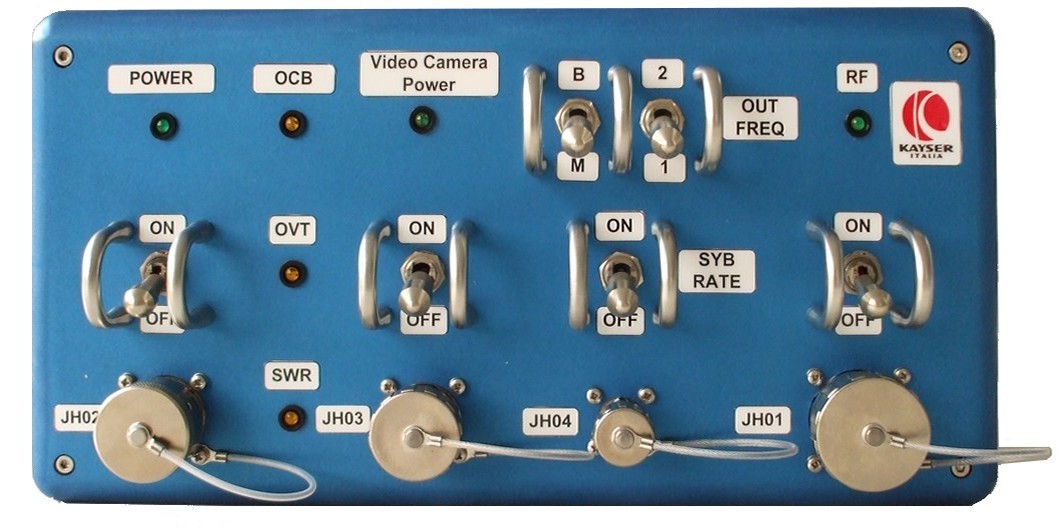ARISS HamVideo Transmitter on board the International Space Station
Name definitions
- “HamVideo” is the name of the Digital Amateur Television (DATV) transmitter on board the Columbus module of the International Space Station (ISS)
- “HamTV” refers to the amateur radio DATV activities involving HamVideo
HamVideo characteristics
- Ham Video downlink frequencies:
- 2369 MHz
- 2395 MHz
- 2422 MHz
- 2437 MHz
- DVB-S modulation
- Symbol rates: 1.3 Ms/s and 2.0 Ms/s
- FEC : ½
- NTSC format (SIF: 352×240 or D1:720×480)
ARISS HamTV ground station setup
A typical ARISS HamTV ground stations comprises:
- 1.2 m dish with AZ-EL tracking (Right Hand Circular Polarization)
- LHCP dish feed (Left Hand Circular Polarization)
- LNB (Low Noise Block downconverter)
- DVB-S satellite receiver / PC Tuner card
- Measurement and Display software
- Tracking software
Parabolic dish
A 1.2 m parabolic dish is recommended, possibly meshed.
The dish shall be mounted for azimuth and elevation pointing and moved by precision motors. with a total system pointing accuracy of 1° or less (including motor precision, antenna alignment, and pointing control software).
The elevation movement shall cover 180 degrees (flip mode capability).
The azimuth movement shall cover 360 degrees or more.
A possible alternative to the flip mode for the elevation movement is the capability of azimuth movement up to 540 degrees to allow for reception of ISS passes over north.
Azimuth angular speed shall be greater than 5°/sec to allow for reception of ISS passes up to 90° elevation. Less angular speed will allow reception of passes with lower elevation.
The AZ-EL motors for the main European ground stations are made by Prosistel
http://www.prosistel.it
The driver is WISP DDE by CX6DD.
Extensive modifications to WISP DDE were made by Piero Tognolatti I0KPT, in order to allow for north passes and Prosistel motor control.
LNB
ARISS-Europe ground stations are equipped with an LNB downconverter produced by Kuhne Electronic. The LNB is designed for mast mounting near the parabola.
Two options are available :
Option 1 :
KU LNC 25 TM ( centered 2450 MHz)
Frequency range : 2350 – 2550 MHz
IF : 1433.5 – 1633.5 MHz
Amplification : 40 dB
http://www.kuhne-electronic.de/en/products/down-converters/ku-lnc-25-tm.html
Option 2 :
KU LNC 23 TM (centered 2385 MHz) – specific DATV
Frequency range: 2320 – 2450 MHz
IF : 1404 – 1534 MHz
Amplification : 40 dB
http://www.kuhne-electronic.de/en/products/down-converters/mku-lnc-23-tm.html
The KU LNC 23 TM has a notch filter on 1.3 GHz for duplex operation : 1.3 GHz (transmit) and 2.3 GHz (receive). This could be useful from the perspective of a planned cross band voice transponder on Columbus.
Another downconverter is produced by Spectra. Please see:
http://www.spectra-bv.nl/downconverter.html
DVB-S satellite receiver with PCI card
A suitable DVB-S satellite receiver PCI tuner card was produced by Techno Trend and can be found on E-Bay.
http://www.technotrend.eu/2920/TT-budget__S2-1600.html
The Techno Trend TT-S2-1600 card fits in a PCI computer slot and supports HD TV (MPEG2 and MPEG4/ H.264) :
- Computer OS : Windows XP, Vista, Windows 7, Windows 8
- CPU for SDTV: at least 800 MHz
- CPU for HDTV: at least P4 3,4 GHz or comparable AMD Athlon (Dual Core recommended) – not needed for Ham TV
- 512MB main storage (1024MB recommended) at least 1GB free hard disc storage
- Graphics card with at least 64MB and DirectX 9 support
- Sound card with DirectX 9 support
Besides the TT-budget S2-1600 card, TechnoTrend produced the TT-S2-3200 card, also suitable.
For H264 encoding and streaming, a good Dual Core or a Quad Core CPU is needed.
Measurement and Display software
Jean Pierre Courjaud F6DZP developed a free software utility providing radio amateurs and DVB technicians a tool that allows Digital ATV (DVB-S) to be measured precisely. Please see :
http://www.vivadatv.org/page.php?p=tutioune-en
This software is available for the TT S2-1600 card. Please see:
http://www.vivadatv.org/viewtopic.php?f=60&t=214
With the above mentioned setup, HamVideo from Columbus can be received, decoded and viewed on a computer screen. Audio is also available.
Caveat : HamVideo transmissions lack Identification Tables. Hence, a commercvial digital TV receiver does not recognize HamVideo signals. The software written by F6DZP adds the missing tables and provides proper decoding.
Noise Power Measurement for antenna alignment
As suggested by Piero Tognolatti I0KPT and with his collaboration, Jean Pierre F6DZP developed a special software for Noise Power Measurement.
With this software, a TT-S2-3200 or a TT-S2-1600 PCI card can be used for Dish alignment by measuring the Sun noise on S-band.
http://www.vivadatv.org/viewtopic.php?f=67&t=212
Streaming video on the Internet
For H264 encoding and streaming video on the Internet, several software solutions exist:
- Adobe Flash Media Live Encoder (FMLE) – free – Win XP, Win7, Win8
- FFsplit – free – Win7, Win8
- Open Broadcaster (OBS) – free – Win7n Win8
- Xsplit – only basic functions are free – Win XP, Win7, Win8
Under Windows XP, the best solution is FMLE.
Sending the video stream, produced by the DVB-S receiving software, to the Internet encoder/streamer software (FMLE, OBS…) needs additional software such as Vcam.

